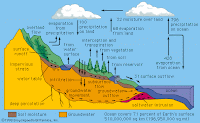The Water Cycle
 |
| The Hydrological Cycle Source - Britannica.com |
Freshwater in the atmosphere
There are approximately 10.5 billion acre-feet of freshwater in the atmosphere.
2% of this freshwater exists as liquid droplets while 98% exists as water vapor.
The freshwater in the air is more than 6 times the freshwater in all the rivers in the world.
Mankind is appropriating 54% of all Freshwater from traditional sources
 |
| Source - unwater.org |
At a population of 6 billion, mankind is appropriating 54% of all the freshwater in rivers, lakes and underground aquifers.
Our freshwater use has grown at a rate that is twice the rate of population growth. Thus, if these rates of increase continue, when the human population hits 9 billion in 2050, we will be appropriating more than 81% of all the freshwater in all the rivers, lakes and underground aquifers.
Difficult Choices
Thus, we have, simply speaking, just two options:
- Dramatically reduce the amount of freshwater we use, or
- Create or open up a new supply source for freshwater
This blog's efforts are focussed on tapping Nature's hydrological cycle at its freshwater source - the atmosphere.
we need your permission to use your image(to use in our Geology Chapter 4.1 image 1) of this url(http://www.google.co.in/imgres?q=Hydrological+cycle&um=1&hl=hi&safe=active&sa=N&biw=1360&bih=579&tbm=isch&tbnid=cD34CthJCgRbeM:&imgrefurl=http://indigenouswater.blogspot.com/2011/04/extracting-freshwater-from-air-is-only.html&docid=YZ9Sy5kwQvnpnM&imgurl=http://2.bp.blogspot.com/-sy5xqd0Vb6U/TdNRJiZstyI/AAAAAAAAAmk/tbsRpxkZwS4/s1600/Hydrological%252Bcycle3.gif&w=594&h=365&ei=bAhTUJ76DcyPrge3wIDACA&zoom=1&iact=hc&vpx=1010&vpy=267&dur=3436&hovh=176&hovw=287&tx=173&ty=101&sig=115057883650139139571&page=2&tbnh=100&tbnw=163&start=21&ndsp=27&ved=1t:429,r:13,s:21,i:178) at ILLL Du for academic purpose so we need copyright permission.
ReplyDeleteilllcopyright@gmail.com
You must approach Encyclopedia Britannica for permission. Encyclopedia Britannica owns the copyright of this illustration.
Delete